标签:png 开发 time run void 第三方库 类类型 invalid image
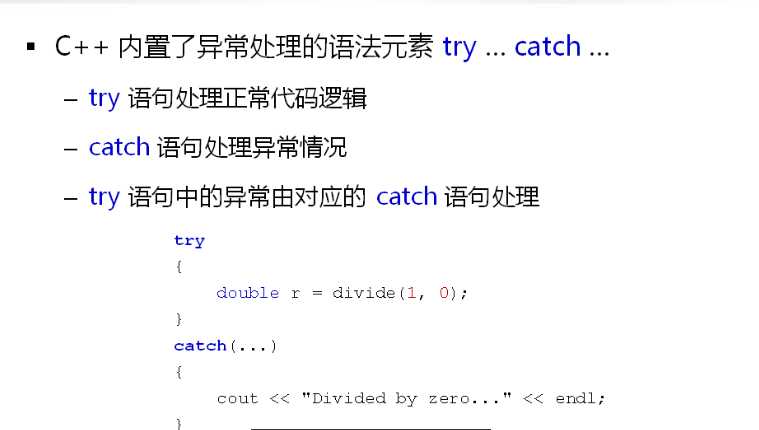
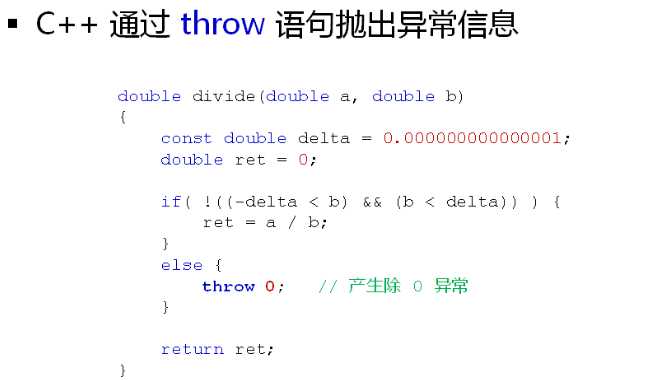
#include <iostream>
#include <string>
using namespace std;
double divide(double a, double b)
{
const double delta = 0.000000000000001;
double ret = 0;
if( !((-delta < b) && (b < delta)) )
{
ret = a / b;
}
else
{
throw 0;//抛出异常
}
return ret;
}
int main(int argc, char *argv[])
{
try
{
double r = divide(1, 0);//divide除数为0时抛出异常,如果不try catch 程序会异常终止
cout << "r = " << r << endl;
}
catch(...)//...表示捕获任何类型的异常 这里divide得异常时 int类型的
{
cout << "Divided by zero..." << endl;
}
return 0;
}
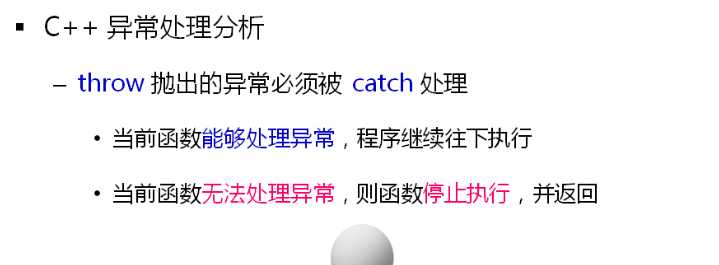
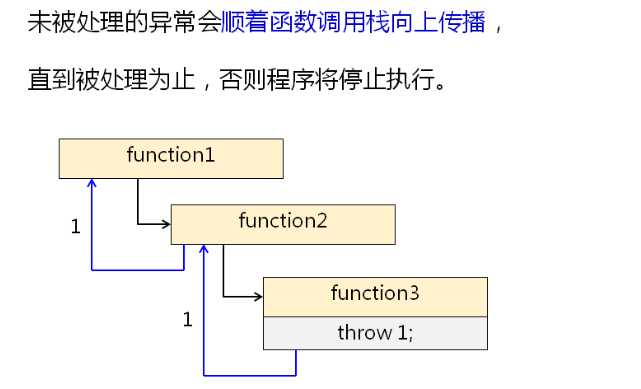
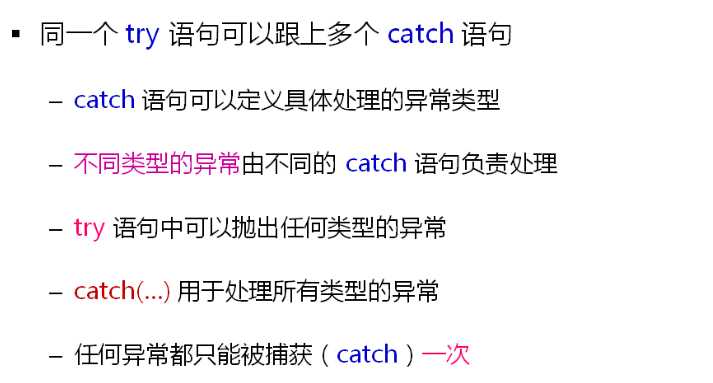
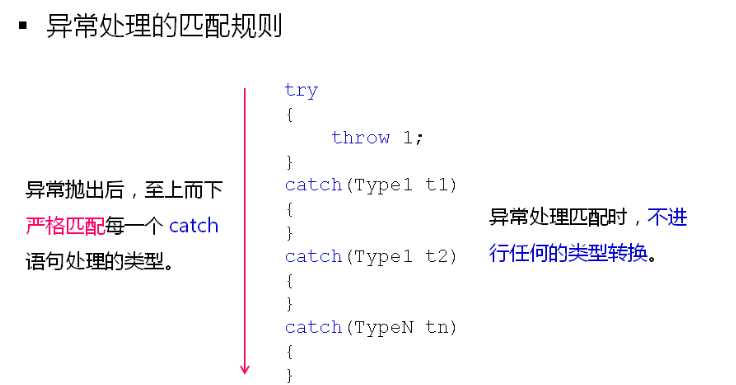
#include <iostream>
#include <string>
using namespace std;
//try 中捕获的异常类型必须跟 cath中的异常类型严格匹配!不进行任何类型转换
//类类型的异常 适用赋值兼容性原则,子类的异常会匹配父类的catch语句
void Demo1()
{
try
{
throw ‘c‘;
}
catch(char c)
{
cout << "catch(char c)" << endl;
}
catch(short c)
{
cout << "catch(short c)" << endl;
}
catch(double c)
{
cout << "catch(double c)" << endl;
}
catch(...)//...语句必须放在最后,捕捉未被catch的任意类型的异常
{
cout << "catch(...)" << endl;
}
}
void Demo2()
{
throw string("D.T.Software");//const char *cs类型
}
int main(int argc, char *argv[])
{
Demo1();
try
{
Demo2();
}
catch(char* s)
{
cout << "catch(char *s)" << endl;
}
catch(const char* cs)
{
cout << "catch(const char *cs)" << endl;
}
catch(string ss)
{
cout << "catch(string ss)" << endl;
}
return 0;
}
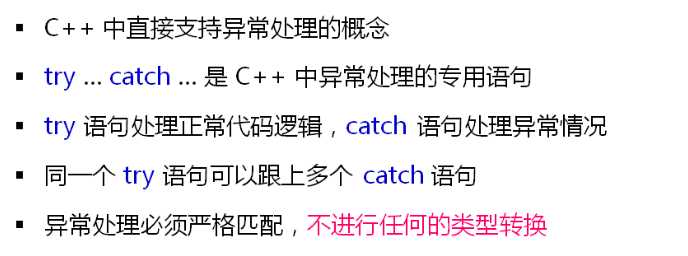
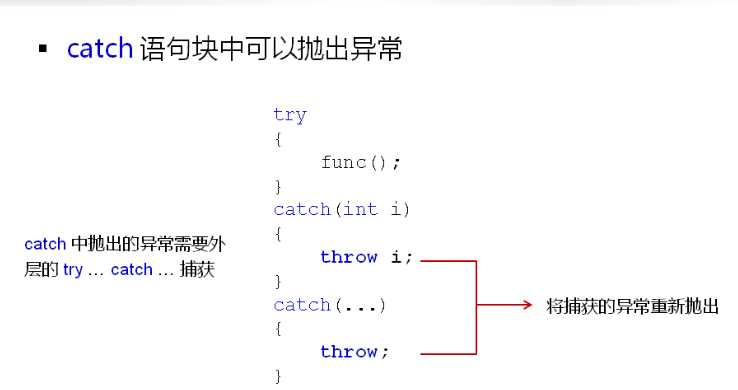
catch语句抛出异常,目的是为了重新定义异常信息:
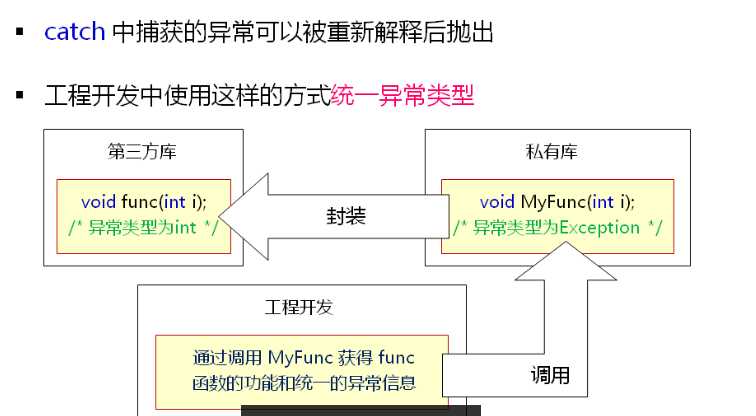
#include <iostream>
#include <string>
using namespace std;
void Demo()
{
try
{
try
{
throw ‘c‘;
}
catch(int i)
{
cout << "Inner: catch(int i)" << endl;
throw i;
}
catch(...)
{
cout << "Inner: catch(...)" << endl;
throw;
}
}
catch(...)
{
cout << "Outer: catch(...)" << endl;
}
}
/*
假设: 当前的函数式第三方库中的函数,因此,我们无法修改源代码
函数名: void func(int i)
抛出异常的类型: int
-1 ==》 参数异常
-2 ==》 运行异常
-3 ==》 超时异常
*/
void func(int i)
{
if( i < 0 )
{
throw -1;
}
if( i > 100 )
{
throw -2;
}
if( i == 11 )
{
throw -3;
}
cout << "Run func..." << endl;
}
//异常的重新定义
void MyFunc(int i)
{
try
{
func(i);
}
catch(int i)
{
switch(i)
{
case -1:
throw "Invalid Parameter";
break;
case -2:
throw "Runtime Exception";
break;
case -3:
throw "Timeout Exception";
break;
}
}
}
int main(int argc, char *argv[])
{
// Demo();
try
{
MyFunc(11);
}
catch(const char* cs)
{
cout << "Exception Info: " << cs << endl;
}
return 0;
}
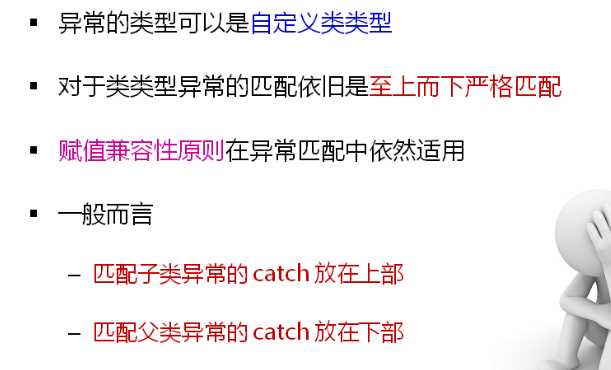
匹配父类异常的catch必须放在最后,否则捕获子类异常的函数将永远不会被执行
#include <iostream>
#include <string>
using namespace std;
class Base
{
};
class Exception : public Base
{
int m_id;
string m_desc;
public:
Exception(int id, string desc)
{
m_id = id;
m_desc = desc;
}
int id() const
{
return m_id;
}
string description() const
{
return m_desc;
}
};
/*
假设: 当前的函数式第三方库中的函数,因此,我们无法修改源代码
函数名: void func(int i)
抛出异常的类型: int
-1 ==》 参数异常
-2 ==》 运行异常
-3 ==》 超时异常
*/
void func(int i)
{
if( i < 0 )
{
throw -1;
}
if( i > 100 )
{
throw -2;
}
if( i == 11 )
{
throw -3;
}
cout << "Run func..." << endl;
}
void MyFunc(int i)
{
try
{
func(i);
}
catch(int i)
{
switch(i)
{
case -1:
throw Exception(-1, "Invalid Parameter");
break;
case -2:
throw Exception(-2, "Runtime Exception");
break;
case -3:
throw Exception(-3, "Timeout Exception");
break;
}
}
}
int main(int argc, char *argv[])
{
try
{
MyFunc(11);
}
//引用作为参数,可以提高程序的执行效率,应为类类型的实参会经过拷贝构造产生一个形参
//直接传递引用可以跳过拷贝构造,提高效率
catch(const Exception& e)
{
cout << "Exception Info: " << endl;
cout << " ID: " << e.id() << endl;
cout << " Description: " << e.description() << endl;
}
//赋值兼容性原则在异常匹配中是适用的,子类异常适合父类异常!
//工程开发中父类的异常捕获放在最后,子类的异常捕获放在最前
catch(const Base& e)
{
cout << "catch(const Base& e)" << endl;
}
return 0;
}
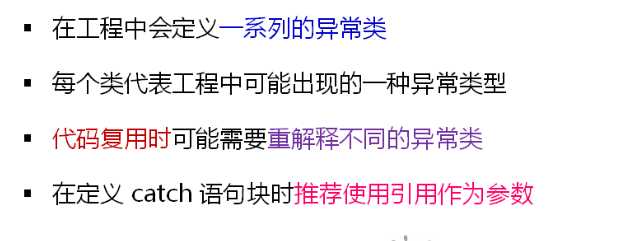
//引用作为参数,可以提高程序的执行效率,应为类类型的实参会经过拷贝构造产生一个形参
//直接传递引用可以跳过拷贝构造,提高效率
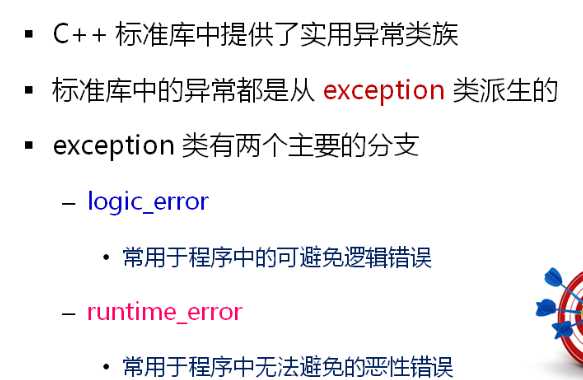
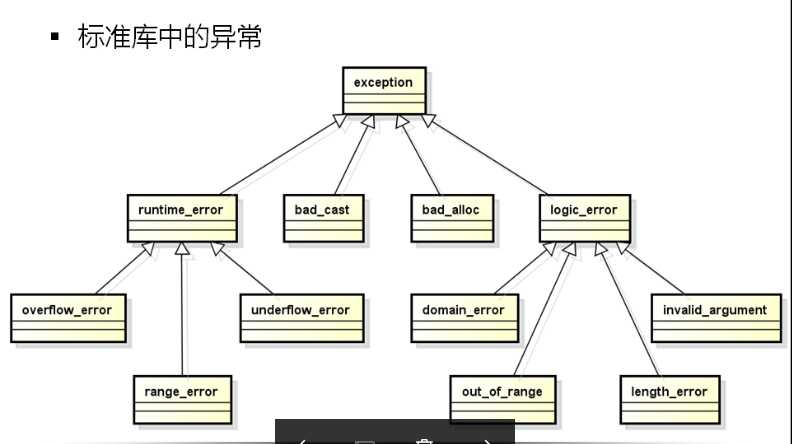

标签:png 开发 time run void 第三方库 类类型 invalid image
原文地址:http://www.cnblogs.com/sunxiaolongblog/p/6696692.html